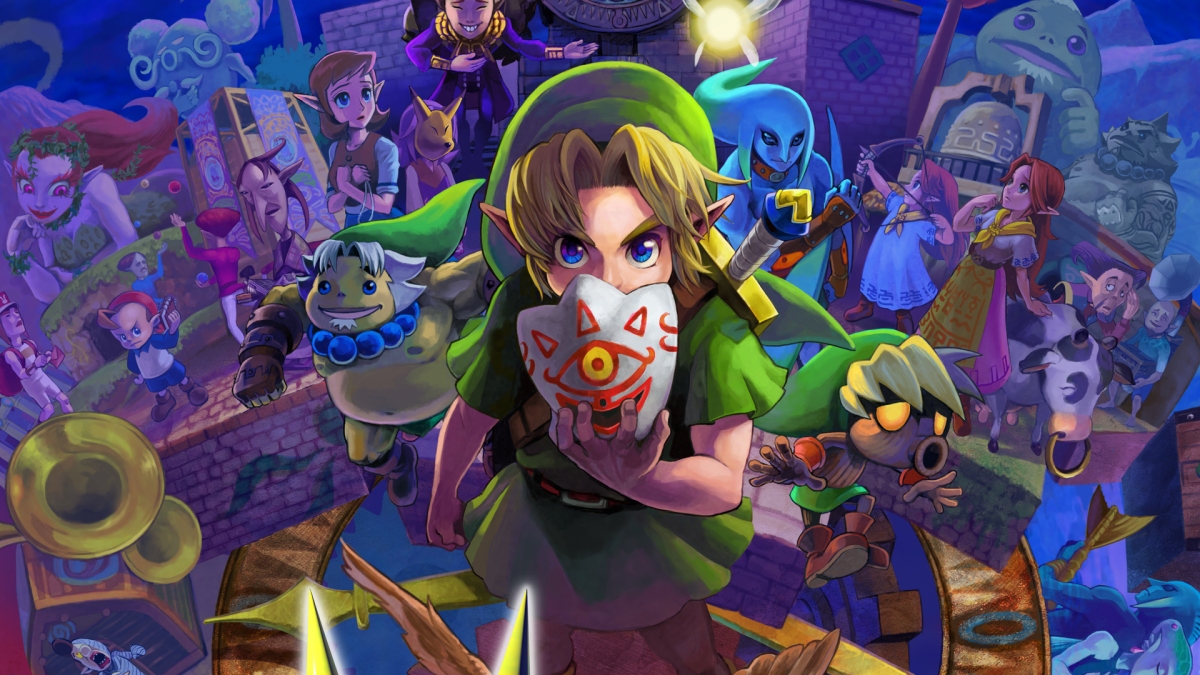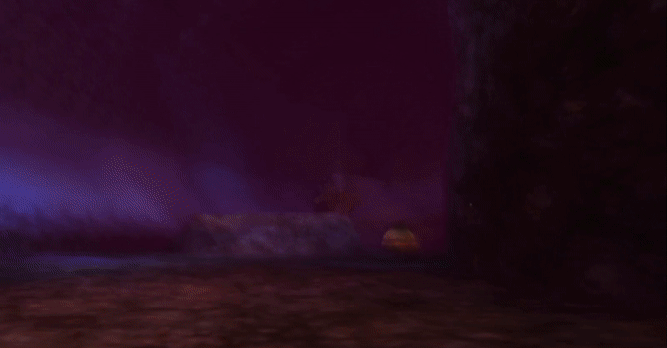Alright, time to talk about one of my favorite games of all time, The Legend of Zelda: Majora’s Mask. It’s an odd one in the Zelda canon, a direct sequel to the seminal Legend of Zelda: Ocarina of Time developed in only a year, known for its oppressively somber atmosphere and mature themes. It’s a game where an ominous title card greets you at the start of each day, counting down to the end of the world. It’s a weird one, which is probably why I love it so much. I was lucky enough to see one of my favorites receive a total remaster, featuring a big leap in hardware from the Nintendo 64 to the newer, portable, Nintendo 3DS. Remakes and remasters are always a fun topic. What actually gets changed in such revisions? What’s sacred and cannot be touched? I wanted to specifically take a look at the boss battle designs of these two versions of the game as Nintendo made some notably significant changes in this area in particular, while much, though not all, of the game’s other mechanics remain faithfully identical between the two versions. I’d like to breakdown a few of the boss designs to see where the design goals of the versions diverged, while thinking about a concept I’ll call player-directed vs environment-directed boss fights. There’s a lot to go over here, so I won’t be breaking down every single mechanic of every fight and what those elements accomplish (Although, that sounds like a lot of fun. Maybe for another time). Moreover, I want to see how the changes made affected my experience with the bosses. Let’s get started.

The first major boss of Majora’s Mask for the Nintendo 64 is the Masked Jungle Warrior Odolwa, a demonic swordsman who commands swarms of carnivorous insects. So I mentioned that Majora’s Mask is a weird game, and even its debut boss is proving this true. Traditionally, Zelda boss fights work in a pretty standard fashion. You receive some new item or weapon, and you utilize it in a specific method to exploit a well-marked weakness the boss has. In this way you progress the encounter, like solving a puzzle. Zelda boss fights are usually not very open-ended. This is not universally the case, but it tends to be the norm. That would be an environmentally-directed boss, where it is aspects of the game’s behavior and scripting that dictate the pace of the fight. One can’t shoot the big-eye monster until it opens its big-eye. Boss encounters that can be progressed at the player’s agency, such as where the boss enemy is always vulnerable, are more player-directed. This is not a binary, and there’s a lot of fluctuation on a spectrum between these two styles of boss design. Zelda partakes in both from time to time, sometimes within the same encounter, though I’d say trending more toward environmental-direction.

Odolwa bucks this trend entirely. You can hit Odolwa at any time with a number of implements. In fact, the weapon you find in Odolwa’s dungeon, the Hero’s Bow, is entirely unnecessary for defeating him. It certainly is advantageous to use it, but entirely optional. Odolwa has no obvious weakness, he has no obvious repeating pattern. He has a collection of patterns and behaviors that respond to the player, of which some leave him open to attack, and others less so. Even still, it’s possible to damage him during times that don’t seem like obvious openings, so long as you can connect sword to swordsman. The sum of this is that ‘openings’ are not taken for granted, not guaranteed progress. There is an element of execution and performance required of the player, instead of just following a script.
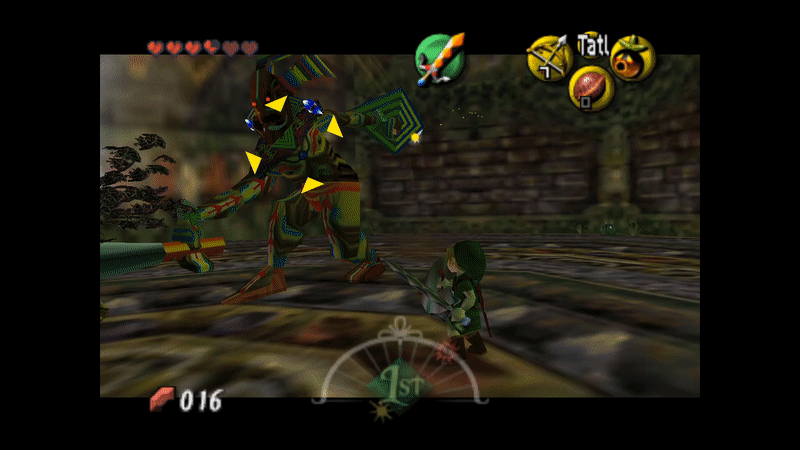
During the fight Odolwa will summon beetles to hound you from the ground, and butterflies to swarm you from the skies. The beetles can be easily dispatched with sword strikes, while the butterflies need to be more carefully maneuvered around. What I find so distinctive about the Odolwa fight for a Zelda First Boss is how firmly the player directs the pace of the fight. I’m never waiting for anything specific to happen, never just nodding along with Odolwa’s preplanned script. Much more than many other Zelda fights, Odolwa’s encounter on the N64 can go in a wide variety of directions very quickly. He’s basically always vulnerable to attack, and so fighting him becomes a skillful test of how the player can handle an increasingly complex bevy of spacial information. So long as I’m willing to risk it, and I have the finesse to get around Odolwa’s shield, I can deal as much damage as I want as quickly as I want, and even end the fight quite promptly.
In the 3DS version of the game, Odolwa’s been altered quite a lot. Immediately attention is drawn to his new, glaring orange eyeball weak spot. I must compliment the animators for how elegantly it’s conveyed in its intro, much more so than such eyeballs will be in later Majora’s Mask 3D bosses, as it does communicate the new direction the design this fight has taken rather well.
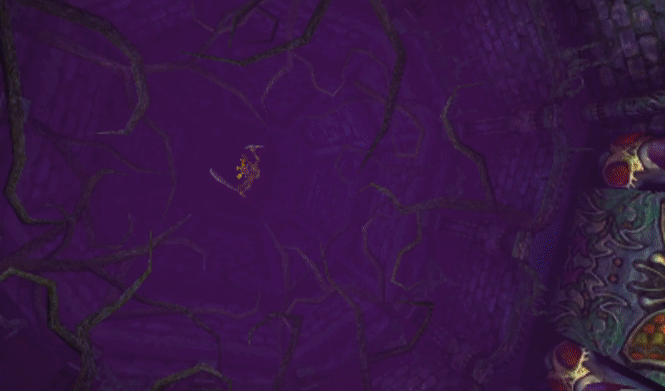
On the other hand, while his weakness is clear, a lot of the aspects that made Odolwa unique, if somewhat intimidating, have been dummied out. For one, it is now impossible to deal sword damage to Odolwa while he is brandishing his sword at you. A bit baffling, to be honest, seeing as how Odolwa is a swordsman. It seems rather obvious a player would want to go blade-to-blade with him, yeah? Whereas in the N64 version, Odolwa would use his shield to make hitting him with the player’s sword more troublesome, here it’s all for show. Odolwa is completely immune to sword strikes period.

Odolwa is once again vulnerable to a variety of attacks, but now they all seem very restrictive, and kind of arbitrary. It seems the goal here was to make the fight more environmentally-directed. One can only damage Odolwa when he presents his new eye, which demands use of the dungeon’s Hero’s Bow item, or the Deku Mask. Perhaps this was in an effort to make the boss more approachable – one advantage of environmentally-directed boss fights is that the player is given a more definitive answer to the problem of how to take down an obstacle, making it more of a puzzle than an actual fight, which is naturally somewhat less stressful. I think there is something to be said for establishing the monsters of Majora’s Mask as these intimidating, aggressive and stress-inducing beasts, however. Some of Odolwa 3D’s changes work against this.

For example, 3D Odolwa suddenly becomes very passive when the player is utilizing a flower with the Deku Mask power, as this is another ‘correct’ answer to the problem of hitting Odolwa’s glowing, orange, eyeball-weak spot. It makes Odolwa seem kind of… stupid, and less of a threat. He stands around patiently to be pelted in the face with an aerial bombardment. It highlights the artificiality of the encounter and could potentially draw a player out of the all-encompassing atmosphere Majora’s Mask is known for. Some of Odolwa’s tricks have also been removed, seemingly, such as his ability to summon a ring of fire to entrap the player. If it seems as though I am being overly harsh on poor Odolwa, it’s just that I really want to highlight the difference in design ethos here. I suspect the 3DS version of this game was meant to be more generally accessible, as Majora was always a niche as far as Zeldas go. These changes seem to be made toward making the experience more familiar to standard Zelda games.

There are games with much more environmentally-directed boss fights than Zelda, where the boss’ behavior is entirely divorced from anything the player does, where the player just has to wait and act as they are meant to, or fail to progress. As I said, there’s a lot of variation out there. Ultimately, a lot of the changes to Odolwa are an issue of presentation. The big eye, the initial immunity to sword strikes; it all builds up this sense that you have to be very specific about how you approach the encounter, where in reality a lot of the same strategies work between both versions of the game. The N64 version is just a lot more free-form, and open to more experimentation, while the 3DS version excels in clarity of its intentions.
From N64 Odolwa I felt the malice of a monster in fighting him. Things got chaotic toward the end as I was engulfed in a ring of fire, my enemy gleefully taunting me from just beyond sword’s reach. Then I realized; I could skewer the arrogant warrior with the bow I found in the dungeon! But I’d have to be careful, man-eating butterflies and beetles swarmed me. It really felt like a struggle for survival. 3DS Odolwa gave me the feeling of solving a puzzle. It’s more like dissecting a more strict set of rules, as Odolwa behaved much more predictably.
Masked Mechanical Monster Goht, our second major boss enemy, sees much less drastic changes than his little brother in the jump from Nintendo 64 to Nintendo 3DS, but there are still some noteworthy ones. Goht is a giant mechanical, erm, goat of sorts with the face of a man. His fight involves chasing him around a circuit in the form of a rolling goron wheel at high speeds. The player’s goron wheel takes some time to rev up, and requires a magic resource to maintain its speed, but once it does, it protrudes spikes that can be used to damage Goht by ramming into him. Hitting his legs deals damage, but hitting his back by going off of a ramp and landing on him knocks him down, allowing the player to strike him directly with powerful punching attacks.
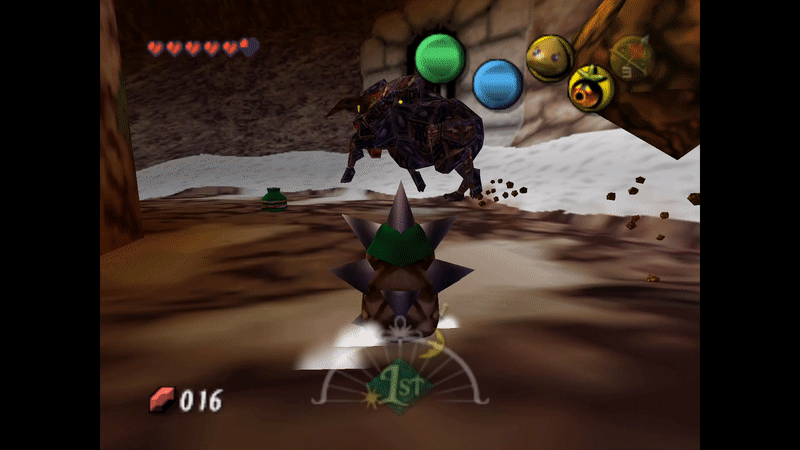
This fight is almost entirely player-directed, entirely open-ended. Chasing Goht is the name of the game, but how you go about this is wholly up to you. Goht is vulnerable at any time, and the pace of the fight is determined by how well the player can execute on the chase. Knocking Goht down is advantageous, but by no means necessary, and the methods to do so are rather open ended, with the complex mechanics of the spinning goron wheel offering a number of options. If ever the player runs low on resources, it is up to them to decide when and how to replenish by hitting the magic jars speeding by on the circuit, and what risks they are willing to take to do so.

As I said, 3DS Goht is mostly the same, but the changes he does have are significant. For one, Goht can now be knocked down by repeatedly hitting his legs, or by landing on top of him. The ramps lining the circuit are now regularly shaped, and require much less speed to initiate a jump. Since Goht can be knocked down either by landing on his back or by clipping his heels now, and since landing on his back is now much easier in this version, the entire decision is less significant. Both options are still there, but neither provides any clear risks or advantages.
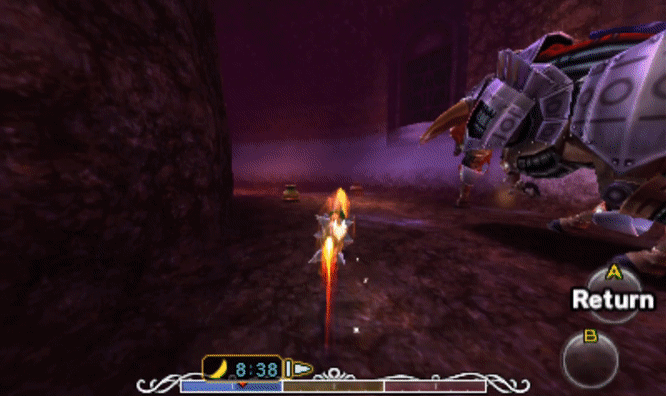
The reason for this is that knocking Goht down is now required to deal direct damage to him. When grounded, Goht reveals a huge eyeball weakspot, in a rather goofy and incongruous fashion. At this point, the player must remove their goron power and take out the dungeon’s item, the Fire Arrows, to deal damage to the eye. This makes the fight simultaneously more stiff, moving away from that more loose player-directed design ethos of the N64 boss fights, if only slightly in this case, while also adding an extra step. It’s a little strange, as though the eyeball only exists as an excuse to make the fire arrows relevant to this boss fight. It also disrupts the pacing of the fight, forcing the player to change from a goron to a human with a slow animation, and then shooting this fast-running monster while standing completely stationary. For N64 Goht, hitting him while knocked down blends seamlessly from chasing him, as one does not even need to change out from being a goron.
The original N64 Goht is such a strange fight for a Zelda game. A high-speed car chase, essentially, complete with bombs, electric gunfire, falling debris, the works. The ability to strike Goht from any angle with the goron wheel adds such an intense dynamism. Thankfully, that’s more or less maintained throughout all versions. The 3DS version of Goht managed to feel mostly reminiscent of the original, which for a remake I think is usually a good thing. Making the ramps for pulling off aerial jumps in the 3DS version more consistent and easier to use may lower the skill floor a bit, but it also lets you do cool fun things more often, so it’s a fair trade. I mean this is only the second boss, after all. The need to pull out the fire arrows occasionally felt like an unnecessary road-bump, and made me roll my eyes a bit (as well as Goht’s, hardy har), but it’s a very minor thing and ultimately the two fights are nearly equally fun.
So it seems the Majora’s Mask 3D remake is going for a lot more environment-direction for its boss fights as opposed to player-direction. In presentation, at least, it gives the impression that the fights are more rigidly defined, with less room for exploratory play. The advantages of such an approach can be a more quantifiable end experience that the developer has more control over, but there are also drawbacks such as the loss of that sense of exploration, experimentation, and realism in the experience. Drawbacks that I’d argue Majora’s Mask wasn’t entirely in need of. I don’t want to give the impression that Majora’s Mask 3D didn’t improve upon the old in some ways. Some accessibility considerations like making the jumps in Goht’s fight easier to pull off will probably make it more fun for most. The heavier involvement of dungeon items in the boss fights make them feel more congruent with the dungeons they’re in, if not necessarily the greater atmosphere of the world. And still, these are only two of Majora’s Masks‘s bosses, but this is running pretty long. I think next week we’ll take a look at the remaining two bosses of the Majora’s Mask superfecta (that’s a trifecta, but four, I just learned). There are definitely some positive changes there that I’m excited to talk about, including ones that exploit the advantages of environment-directed boss design. Hope to see you there.

Certainly, he had far too many weaknesses to use my power…
